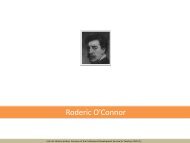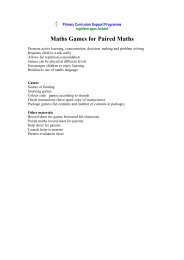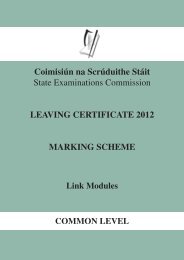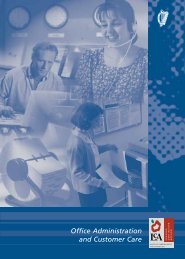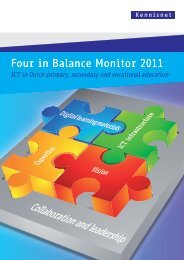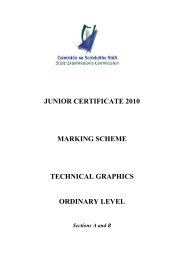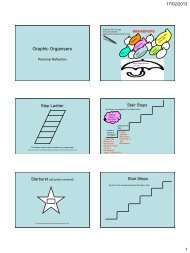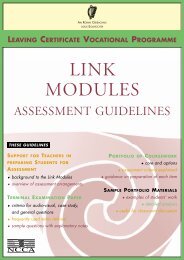GUIDELINES FOR TEACHERS - Curriculum Online
GUIDELINES FOR TEACHERS - Curriculum Online
GUIDELINES FOR TEACHERS - Curriculum Online
Create successful ePaper yourself
Turn your PDF publications into a flip-book with our unique Google optimized e-Paper software.
PHYSICS<br />
considered: for example, it is appropriate to measure a<br />
child’s temperature with a clinical thermometer or a colour<br />
thermometer. Thermometers do not always agree.<br />
The activity described in the syllabus links this approach<br />
with the traditional reference points for the Celsius scale.<br />
The associated experiment is discussed in section 6.3.<br />
3.3.3 SOUND INTENSITY LEVEL<br />
An awareness of sound intensity levels and noise<br />
pollution is important to students as citizens. Students<br />
are to be introduced to the threshold of hearing and the<br />
frequency response of the ear. This can be easily demonstrated<br />
using a signal generator and loudspeaker. Individual<br />
differences and changing frequency responses with age<br />
need to be emphasised. Students can use sound level meters<br />
to measure sound intensity levels (in dB(A)) in a variety of<br />
local environments. Through this section students can begin<br />
to appreciate the effect of different sound intensity levels<br />
on hearing and how to protect their own hearing.<br />
3.3.4 SOURCES OF EMF<br />
The syllabus requires students to understand the<br />
definition of potential difference and to know that it is<br />
measured in volts. The fact that pd and voltage are different<br />
names for the same quantity is to be appreciated. When a<br />
voltage is applied to a complete circuit it is called an emf.<br />
This is also measured in volts. Sources of emf are to be<br />
reviewed.<br />
3.3.5 CONDUCTION IN MATERIALS<br />
The approach taken is to investigate conduction in<br />
circuit components through measurement of<br />
the current, I, and the pd, V, in appropriate circuits.<br />
The different I-V graphs lead to an appreciation of<br />
the nature of the materials and the charge carriers. The<br />
associated experiment is discussed in section 6.3.<br />
3.3.6 ELECTRONICS<br />
There is no separate section on electronics in the<br />
Ordinary level syllabus. Students are introduced to<br />
semiconductors as one of the materials studied in relation<br />
to conduction. This is followed by an overview of intrinsic<br />
and extrinsic conduction and the p-n junction.<br />
3.3.7 IONISING RADIATION<br />
AND HEALTH HAZARDS<br />
This approach in the syllabus extends the appreciation<br />
of health hazards associated with ionising radiation to<br />
include the type of source, the activity of the source, the<br />
time of exposure, and the type of tissue irradiated. The aim<br />
is to enable students to appreciate how exposure to ionising<br />
radiation can harm health and yet how ionising radiation<br />
can be used in the treatment of disease.<br />
3.4 ISSUES IN ORDINARY LEVEL PHYSICS<br />
Three aspects of Ordinary level physics are discussed in<br />
this section. They are language, mathematics and the<br />
teaching of physics at this level.<br />
3.4.1 LANGUAGE<br />
Learning physics requires appropriate language skills on<br />
the part of the student. Firstly, a reasonable<br />
command of a student’s first language is required: students<br />
need to be able to understand and use words such as<br />
estimate, phenomenon, illustrate, initial and accurate or<br />
their equivalent in other languages. These non-technical<br />
words may be a barrier to students’ understanding.<br />
Secondly, students need to understand and be able to use<br />
technical words. Words such as conservation, amplitude and<br />
force are essential for working with the subject. At this level,<br />
students have to be able to distinguish between the everyday<br />
meaning of words such as work, energy, pressure, and<br />
power, and their technical meaning. Finally, students have to<br />
comprehend the language used in examinations and then<br />
convey their understanding of physics in writing.<br />
As a general principle, it is agreed that students should<br />
be assessed on their knowledge, understanding and<br />
skills in physics, not their first language. However, it is<br />
important that they can use the language needed to display<br />
their knowledge, understanding, and skills.<br />
Strategies for developing students' language confidence<br />
and competence are essential if Ordinary level students<br />
are to feel that they can ‘do’ physics. A number of<br />
approaches are possible. Students’ comprehension of both<br />
technical and non-technical words can be helped by<br />
developing appropriate teaching strategies. These might<br />
include using illustrations and diagrams to complement the<br />
spoken word, compiling a glossary of technical terms as part<br />
of the summary or revision work on a topic, and providing<br />
opportunities for students to talk or write using the words in<br />
a range of contexts. This may seem to take up valuable<br />
classroom time, but if students do not comprehend the words<br />
used in class then they can make little sense of the work.<br />
15



